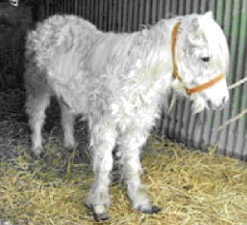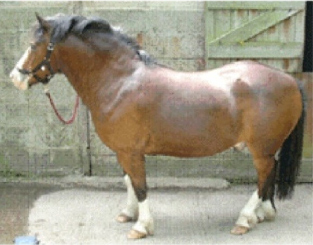
Aged pony with the typical long, hairy coat classical of Cushing’s Disease.
Ever
wondered why your little mini or pony seems to gain weight on thin air alone, or why he
or she keeps getting bouts of laminitis again and again even though you’ve tried
so hard to prevent it? Well, you’re pony may in fact be suffering from Equine
Cushing’s Disease and/or Equine Metabolic Syndrome. The following fact sheet
will help you understand more about these relatively common, but often
misunderstood and confusing, conditions.
EQUINE CUSHING'S DISEASE
What is Equine Cushing's Disease? Equine Cushing's Disease, also known as Pars Pituitary Intermedia Dysfunction (PPID), is a disorder of the endocrine system (organs that are involved in the release of hormones). Cushing’s Disease can affect all breeds and it is primarily seen in older horses above the age of 15 years. Cushing's Disease is caused by enlargement of the pars intermedia (middle section) of the pituitary gland. The pituitary gland is located at the base of the brain and is an important endocrine organ that produces a variety of different hormones. Dysfunction of the pars intermedia results in the increased release of several hormones, including ACTH (adrenocorticotropin hormone). ACTH travels through the horse’s blood stream and causes the adrenal glands (located near the kidneys) to increase production of cortisol, which is a type of steroid. It is this over production of cortisol that affects the horse and can explain the majority of clinical signs seen in this condition.
What does Equine Cushing's look like? Recurrent and often unexplained bouts of laminitis along with an abnormal hair coat are two of the most common clinical signs of a horse with Cushing's. Other signs include lethargy, a pot-bellied appearance, increased urination and drinking, and a decrease in the immune system resulting in signs such as recurrent skin and respiratory infections, dental disease and an increased susceptibility to worms. With Cushing's Disease horses may also suffer wasting of their skeletal muscles or develop an abnormal deposition of fat above their eye where normal horses would have a depression. The abnormal hair coat can vary from delayed shedding of the winter coat to the development of a long (up to 10cm), thick and wavy overgrown coat (Fig. 1). This strange coat characteristic is known as ‘hirsutism’.

Aged pony with the typical long, hairy coat classical of Cushing’s Disease.
The link
between Equine Cushing's Disease and laminitis is still not fully understood. It
is currently believed that the increased levels of circulating cortisol and
cortisol-like hormones may play a major role in the development of laminitis, as
well as a metabolic state known as ‘insulin resistance’.
How is Cushing's Disease diagnosed?
In classic cases (i.e. old pony with hirsutism and recurrent laminitis) a
diagnosis can be made on presentation alone, but not all Cushing's cases have
obvious clinical signs. When investigating subtle signs or when a definitive
diagnosis is wanted there are several tests your veterinarian can conduct.
The most common test performed to achieve a diagnosis of Equine Cushing's
Disease is by taking a resting non-stressed blood sample to test for the hormone
ACTH. Often we will also test for signs of the equine metabolic syndrome (EMS;
see below) as well by measuring some other hormones at the same time. Sometimes
more detailed tests are required to confirm Equine Cushing's Disease and these
are known as ‘stimulation’ or ‘suppression’ tests. These require slightly more
blood sampling and take longer but give a more detailed picture of how the
pituitary gland is working. These more detailed tests are of most use when the
signs and/or the resting hormone values are equivocal.
Treatment and Management of Equine Cushing's Disease
Unfortunately there is no cure for Cushing's Disease but there are a couple of
drugs available that can help reduce the effects of the disease and aid in
managing the affected horse.
Pergolide (Prasscend™, licensed for horses) is probably the most commonly used
Cushing's disease medication and by far the most effective. It comes in tablet
form that can be crushed up and fed in feed or hidden inside a treat and is
given once per day. Pergolide is a dopamine agonist which reduces the
over-production of ACTH so reduces cortisol and has been reported to be up to
80% successful in reducing the severity of signs of Cushing’s Disease.
Trilostane (Vetoryl™, licensed for dogs only) is another drug often used in the
medication of horses and ponies with Cushing's Disease. This drug acts by
inhibiting cortisol and is required to be given twice per day, morning and
night.
Management is just as important as medicating horses with Cushing’s Disease and
is vital in horses not receiving any medication. Frequently inspecting for
wounds and evidence of any kind of infection and ensuring prompt veterinary
attention is very important as affected horses have reduced levels of immunity
and often need more intensive and prolonged treatment than other horse. Regular
farrier visits and dental checks along with routine vaccinations and a
de-worming program involving frequent faecal egg counts are vital to ensure the
health of Cushing's affected
horse. Simple things like clipping out excessive hair will also go a long way in
ensuring the comfort of affected horses.
EQUINE METABOLIC SYNDROME
What is Equine Metabolic Syndrome?
Equine Metabolic Syndrome (EMS) is a veterinary term used to describe horses
presenting with obesity and/or large regional fat deposits (‘regional
adiposity’), insulin resistance and recurrent laminitis. EMS usually affects
young to middle aged horses and is more common in native pony-type breeds.
A horse with metabolic syndrome is typically a “good doer”, i.e. easily becomes
obese and seems to gain weight on very little food intake. Large regional fat
deposits can be seen most commonly in the crest of the neck (‘cresty neck’) but
also around the shoulders, at the base of the tail, in and around the mammary
glands in mares and in geldings a fat filled and enlarged sheath may be seen
(Fig. 2).
As with Cushing's Disease, the association between EMS and recurrent laminitis
is still not fully understood but it is believed that there is a link between
the occurrence of insulin resistance and the predisposition for laminitis.

Obese pony with equine metabolic syndrome and the typical 'cresty neck'
appearance.
What is Insulin Resistance?
Insulin resistance is a reduction of the horse’s ability to respond
appropriately to the
hormone insulin. Insulin is involved in the uptake of glucose from the
bloodstream
following eating and it’s storage in cells; therefore with insulin resistance
this very
important mechanism no longer functions properly. The body tries to counteract
its
own insensitivity to insulin by producing more
and more insulin, and it is the
elevated
level of insulin that tells us that insulin resistance is occurring.
Obesity, as
a direct result of excessive calorie intake, is the primary cause of insulin
resistance in horses (as with people). It is now known that fat, or ‘adipose
tissue’ is
not just an inactive lump of fat cells but produces a wide range of hormones
(‘adipokines’) and inflammatory mediators (‘cytokines’). These adipokine hormones
down
-regulate the sensitivity of tissues to insulin, which is a normal body function,
but when they are produced to excess by larger than normal deposits of fat,
their
down-
regulatory action is too much for the body to cope with and insulin resistance
occurs. The excessive production of inflammatory mediators by the fat tissue
also
leads to a constant state of low grade inflammation.
Why are Ponies so Susceptible to EMS? Ponies, especially native breed ponies, evolved to survive in harsh conditions and endure long periods with sparse amounts of grass. Their highly efficient
metabolic system would allow them to store fat during the lush spring and summer months so that they could draw on these reserves during the winter months to survive. Ponies now have access to far more calories that they were designed to cope with due to
the improved pastures they now graze on, haylage and feeding of concentrates.
How is Equine Metabolic Syndrome Diagnosed? History alone is often highly suggestive in EMS cases but as some of the clinical signs can be subtle and easily confused with Equine Cushing's Disease, it is
important to rule out the presence of this disease. There is no definitive test for Equine Metabolic Syndrome so your veterinarian may use a variety of blood tests looking mainly for elevated glucose and insulin concentrations.
Treatment and Management of Equine Metabolic Syndrome? The key to treating and managing EMS is weight loss and exercise. This takes a lot of discipline and persistence on the owner’s part! Obese horses should be placed
on a diet solely composed of hay plus a vitamin and mineral supplement with absolutely no access to pasture. The hay should be mature grassy hay with a high stem to leaf ratio. Legume hays such as alfalfa should be avoided as these contain more
energy, however if this is the only hay available, it should be soaked in water for at least 30 minutes to leach out the soluble sugars. If in doubt, it’s better to soak than not to soak hay. The amount of hay being fed should be 1.5% of the IDEAL (not current)
body weight (e.g. 3kgs dry weight for a 250 kg pony that should be 200kg). The hay should be weighed to ensure the correct amount is being fed. This amount of food should be continued until the ideal body weight is achieved. You can reduce this
to 1% of ideal body weight if no weight loss has occurred after 30 days but never feed less than 1% as severe calorie restriction can cause worsen insulin resistance and
cause other severe conditions as hyperlipaemia. Exercise is the other crucial component in tackling EMS. It is recommended that, as soon as laminitic feet are sound, the pony is started on a program of 2-3 sessions, lasting 20-30 minutes, of moderate intensity exercise per week. Intensity
and duration should be gradually increased over time. Exercise not only aids
weight
loss but also increases insulin sensitivity, even if weight loss does not occur.
Confused? Don’t worry, Equine Metabolic Syndrome and Equine Cushing's Disease share some similarities and are confusing diseases -lots of veterinarians are still confused by them! If you think your horse or pony has any clinical signs similar to described above, contact your vet to discuss investigating Cushing's or EMS -it’s relatively easy, non invasive and you may be able to really make a difference to your horse or pony’s life.
Credits
The Dick Vet Equine Practice Easter Bush Veterinary Centre
You may click here for a copy of this article:
cushings-disease-and-metabolic-syndrome.pdf
Do you
have a topic you would like to see here or article you'd like to submit?
Please
E-mail me
We wish to thank all of the people that have shared their experiences &
knowledge with others by sending us tips and donating articles. For articles on
our pages that have been reproduced, credit is given and a link is posted to
your site (reproducing articles archives information on our server which
decreases broken links that occur when content on the site was either removed or
relocated without proper redirects in place to lead visitors to the correct
page.)
Please forgive us if we did not give full credit for any one of the wonderful articles
here. If we have used something of yours
that you would like removed please let me know.
All rights reserved. No part of any pages may be reproduced in any form or
means without written permission of Lil Beginnings Miniature Horses.
Lil Beginnings Miniature Horses is not responsible for any death, injuries, loss, or other damages which may result from the use of the information in
our pages.